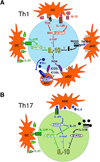IL-10 production by CD4+ effector T cells: a mechanism for self-regulation
- PMID: 20200511
- PMCID: PMC4105209
- DOI: 10.1038/mi.2010.8
IL-10 production by CD4+ effector T cells: a mechanism for self-regulation
Abstract
The development of Th1 lymphocytes is essential for cell-mediated immunity and resistance against intracellular pathogens. However, if left unregulated, the same response can cause serious damage to host tissues and lead to mortality. A number of different paracrine regulatory mechanisms involving distinct myeloid and lymphoid subpopulations have been implicated in controlling excessive secretion of inflammatory cytokines by Th1 cells. Much of this work has focused on interleukin (IL)-10, a cytokine with broad anti-inflammatory properties, one of which is to counteract the function of Th1 lymphocytes. While studying the role of IL-10 in regulating immunopathology during infection with the intracellular parasite Toxoplasma gondii, we discovered that the host-protective IL-10 derives in an autocrine manner from conventional interferon-gamma (IFN-gamma)-producing T-bet(+) Foxp3(neg) Th1 cells. In the following review, we will discuss these findings that support the general concept that production of IL-10 is an important self-regulatory function of CD4(+) T lymphocytes.
Conflict of interest statement
The authors declare no conflict of interest.
Figures


References
-
- Moore KW, et al. Interleukin-10. Annu. Rev. Immunol. 1993;11:165–190. - PubMed
-
- Fiorentino DF, et al. 1991. IL-10 inhibits cytokine production by activated macrophages. J. Immunol. 1991;147:3815–3822. - PubMed
-
- Kühn R, et al. Interleukin-10-deficient mice develop chronic enterocolitis. Cell. 1993;75:263–274. - PubMed
Publication types
MeSH terms
Substances
Grants and funding
LinkOut - more resources
Full Text Sources
Other Literature Sources
Medical
Research Materials

